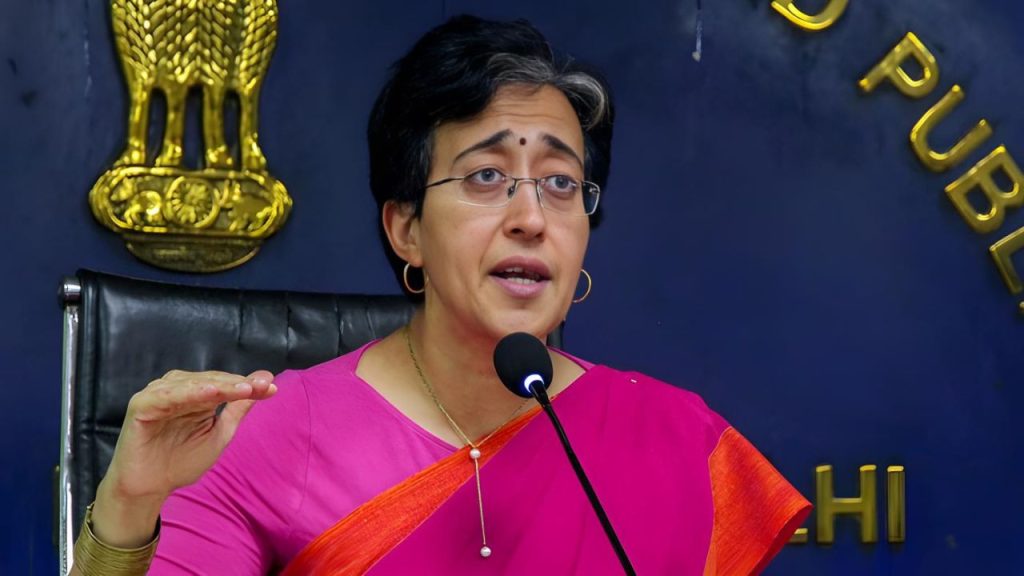
Delhi, August 2024 – In a decisive move, Delhi Minister Atishi has taken a strong stance on the persistent issue of sewer overflow plaguing the capital. The problem, which has been a cause of significant concern for residents across various parts of the city, has prompted Minister Atishi to issue a directive to the Chief Secretary of Delhi, demanding immediate and effective action to address what she has termed as an “unacceptable” situation.
Background of the Issue
Sewer overflow has long been a challenge in Delhi, a city with a rapidly growing population and aging infrastructure. The capital’s sewer system, much of which dates back several decades, has struggled to keep pace with the increasing demand placed on it by the city’s expanding population and urban sprawl. During the monsoon season, the problem often becomes more acute, with heavy rainfall overwhelming the already burdened sewer systems, leading to frequent overflows in many neighborhoods.
Residents in several areas of Delhi have repeatedly voiced their frustration over the recurring issue, which not only causes significant inconvenience but also poses serious health risks. Sewage flooding into streets and even homes has become a common occurrence, leading to unsanitary conditions, the spread of waterborne diseases, and severe disruptions to daily life.
Minister Atishi’s Response
Minister Atishi, who has been vocal about the need for improving Delhi’s infrastructure and ensuring basic amenities for all citizens, expressed her deep concern over the ongoing sewer overflow issue. In her directive to the Chief Secretary, she emphasized that the current state of affairs is not just a matter of inconvenience but a grave failure of public service delivery.
Atishi’s response reflects her commitment to addressing issues that directly impact the lives of Delhi’s residents. By taking a firm stand on this issue, she has made it clear that the status quo is no longer acceptable. Her directive underscores the urgency of the situation and the need for immediate remedial measures.
The Directive
In her directive to the Chief Secretary, Minister Atishi outlined a clear set of expectations. She called for a comprehensive assessment of the current sewer infrastructure in the affected areas, identifying the root causes of the frequent overflows. She also demanded the formulation of an actionable plan to address these causes, with a focus on both short-term relief measures and long-term solutions.
Atishi’s directive includes the following key points:
Immediate Relief Measures: The Chief Secretary has been instructed to deploy emergency teams to the most severely affected areas to mitigate the impact of ongoing sewer overflows. This includes clearing blockages, repairing damaged sewer lines, and ensuring that any stagnant sewage is promptly removed to prevent the spread of diseases.
Infrastructure Assessment: A detailed assessment of the existing sewer infrastructure is to be conducted, focusing on identifying areas where the system is most vulnerable to overload. This assessment should also include an analysis of the capacity of current sewer lines, the effectiveness of existing pumping stations, and the condition of treatment plants.
Long-Term Solutions: The directive calls for the development of a long-term plan to upgrade Delhi’s sewer infrastructure. This plan should address the need for expanding sewer capacity in rapidly growing areas, replacing outdated sewer lines, and enhancing the city’s ability to manage heavy rainfall during the monsoon season.
Regular Monitoring and Accountability: Minister Atishi has emphasized the importance of regular monitoring and accountability in the implementation of these measures. She has called for the establishment of a dedicated task force to oversee the progress of the proposed actions, with regular reports to be submitted to her office. Additionally, she has stressed the need for holding officials accountable for any lapses or delays in addressing the issue.
Public Reaction
The public response to Minister Atishi’s directive has been largely positive, with many residents expressing relief that the issue is being taken seriously at the highest levels of government. Citizens in the affected areas have long been calling for urgent action, and Atishi’s intervention has given them hope that the situation might finally see a resolution.
However, some have also voiced skepticism, noting that similar promises have been made in the past without substantial follow-through. There is a sense of cautious optimism, with many residents waiting to see if the directive will translate into tangible improvements on the ground.
The Broader Implications
The sewer overflow issue in Delhi is symptomatic of the broader challenges faced by the city’s infrastructure. As one of the largest and most populous cities in India, Delhi’s rapid growth has outpaced the development of its public utilities, leading to a range of problems, from water shortages to inadequate waste management.
Minister Atishi’s focus on the sewer issue is indicative of her broader agenda to address these infrastructural challenges. By prioritizing the improvement of basic amenities, she aims to enhance the quality of life for all of Delhi’s residents, particularly those in underserved areas.
Furthermore, her directive highlights the importance of sustainable urban planning in addressing the root causes of such problems. As Delhi continues to grow, there is a pressing need for forward-thinking policies that anticipate future demands on the city’s infrastructure and ensure that it can meet these demands without compromising on service delivery.
Moving Forward
The success of Minister Atishi’s initiative will ultimately depend on the effective implementation of the measures outlined in her directive. While the directive itself is a positive step, it must be followed by concrete actions on the ground. The Chief Secretary’s office will play a crucial role in driving these efforts, and there will be significant public scrutiny on how the situation is handled in the coming weeks and months.
For the residents of Delhi, the hope is that this directive marks the beginning of a sustained effort to resolve the sewer overflow issue once and for all. If successful, it could set a precedent for how other infrastructure challenges are addressed in the city, paving the way for a more resilient and livable Delhi.
Conclusion
Minister Atishi’s decisive action on the sewer overflow issue reflects her commitment to addressing the critical infrastructure challenges facing Delhi. By directing the Chief Secretary to take immediate and effective measures, she has sent a clear message that the current state of affairs is unacceptable and that residents of Delhi deserve better. As the situation unfolds, all eyes will be on the government’s response, with the hope that this marks the beginning of meaningful and lasting change in the capital’s infrastructure.
